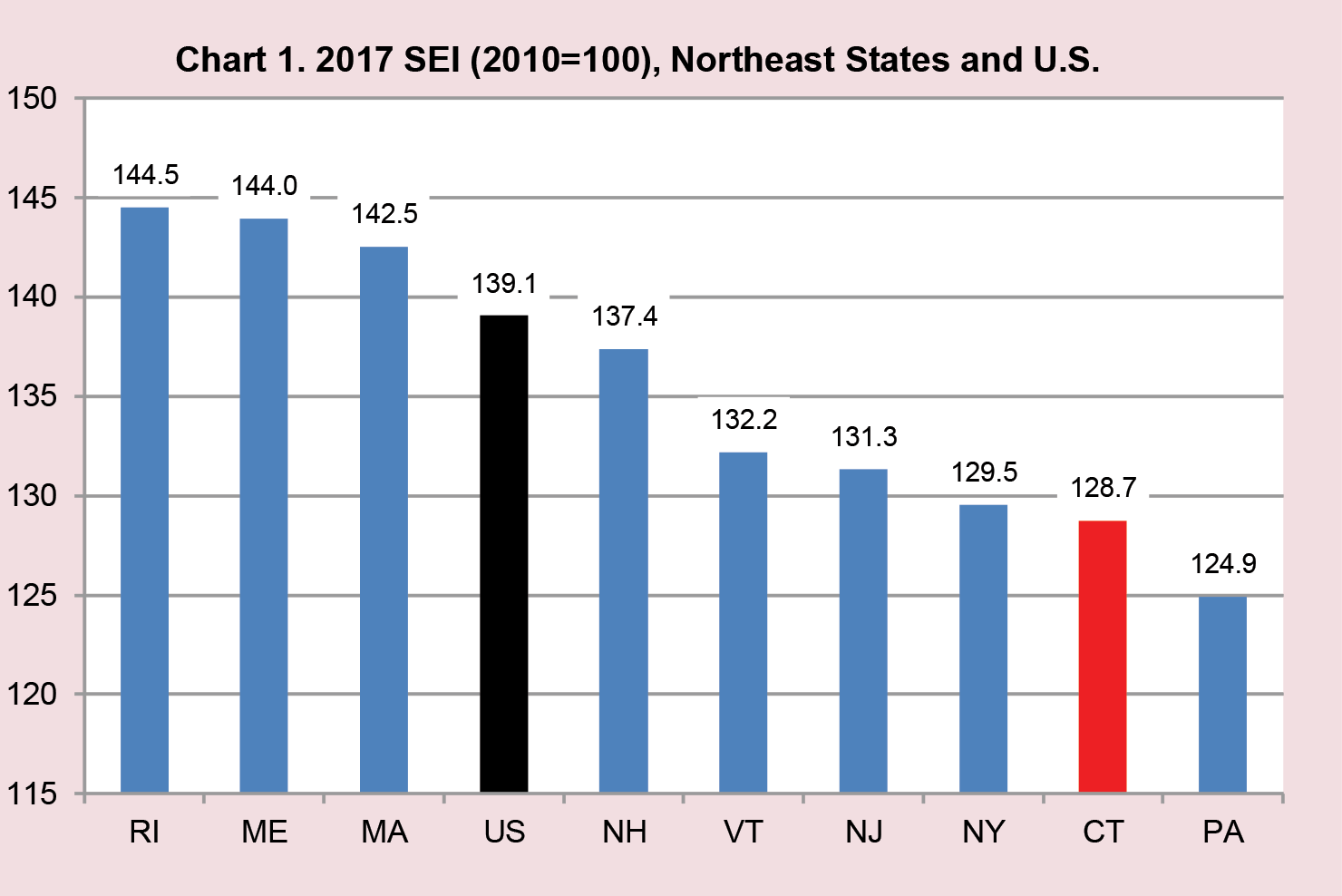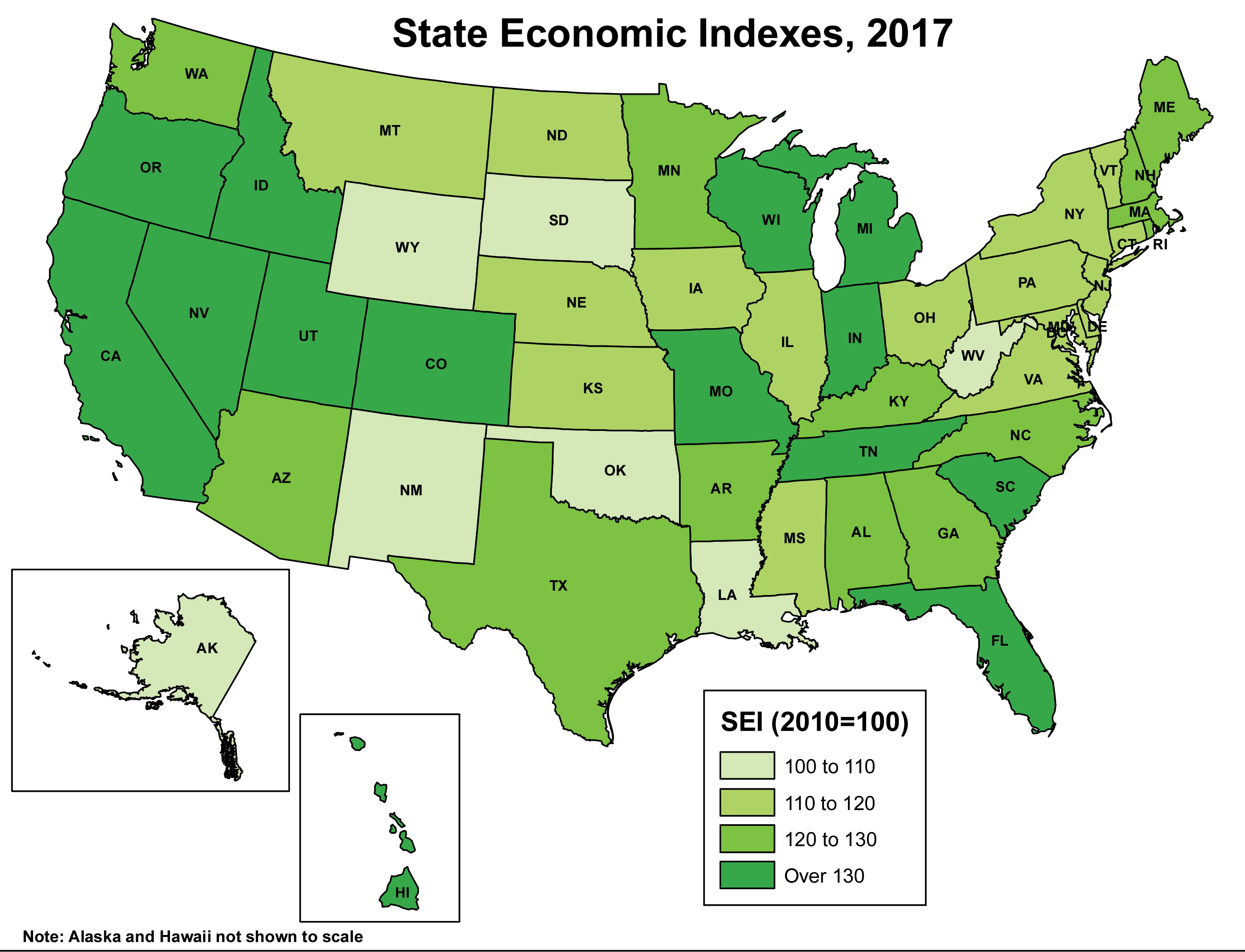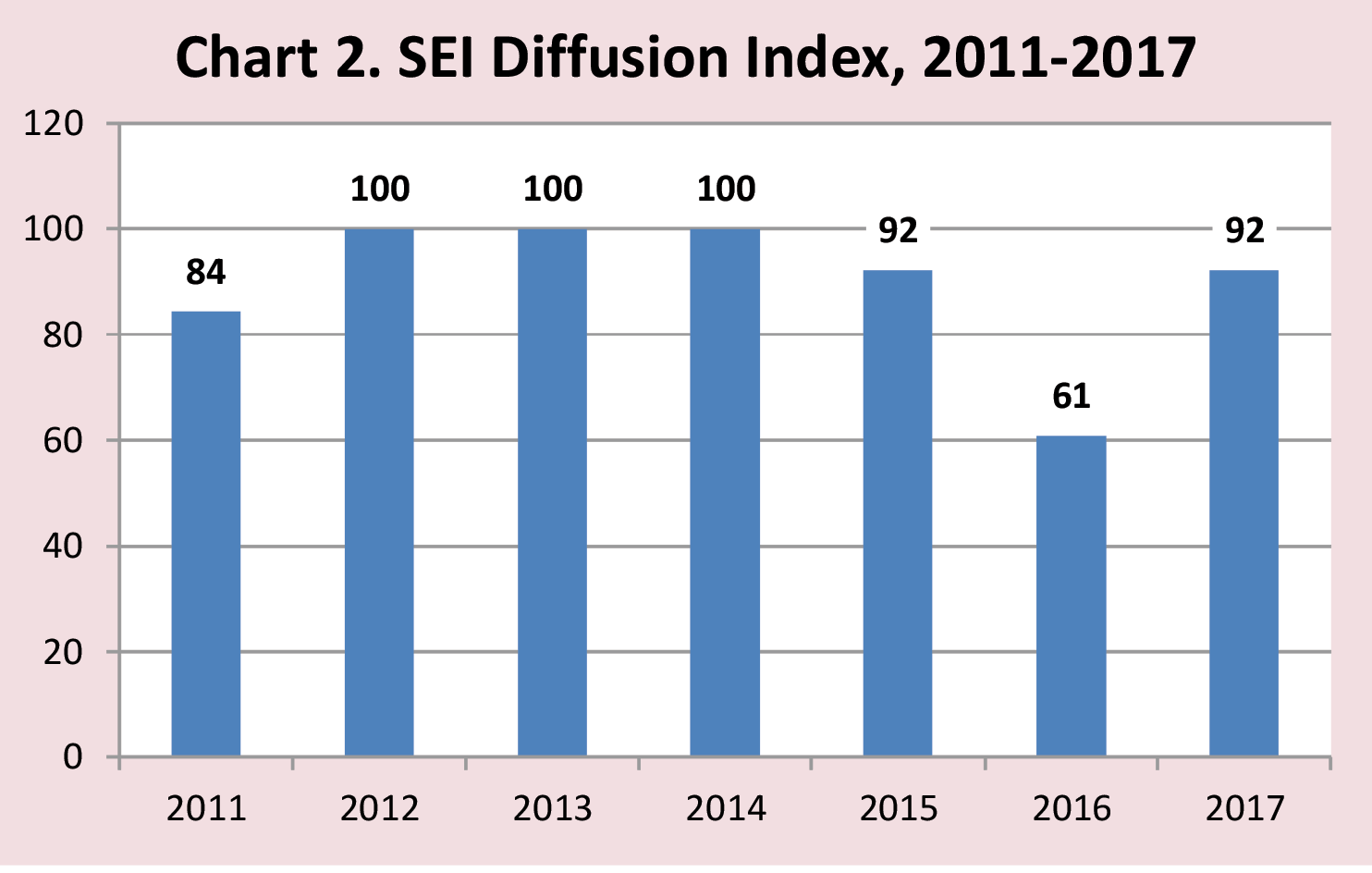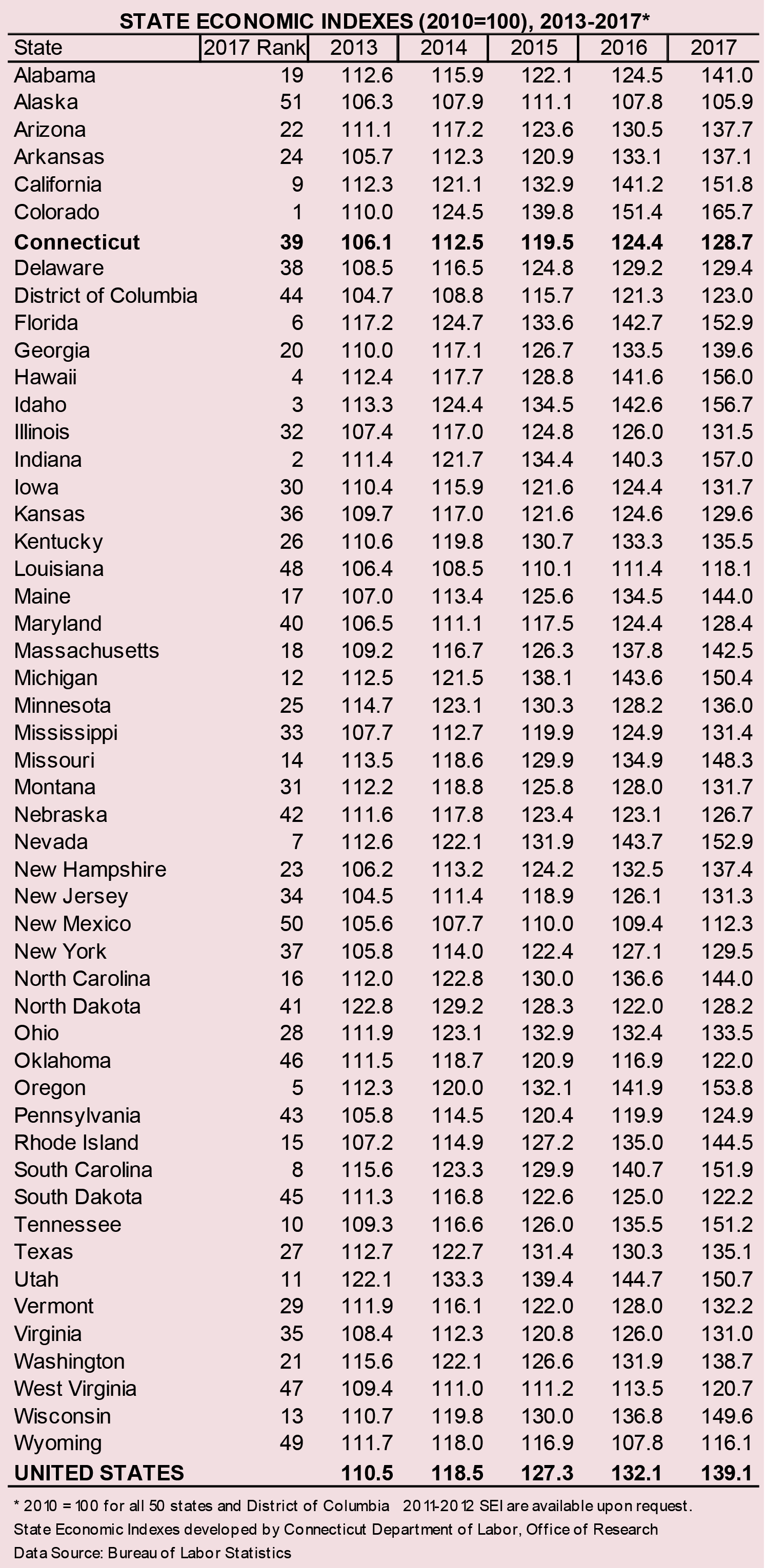
2017 State Economic Indexes
By Jungmin Charles Joo and Dana Placzek, DOL
After annual revisions, Connecticut ranked 39th out of the 50 states and the District of Columbia (DC) in the State Economic Indexes (SEI) in 2017, up from the 40th position in 2016. In fact, last year’s overall economic performance was the best in terms of the ranking in seven years.
For the third year in a row, Colorado came in first in the nation with the highest index of 165.7 last year, while Alaska ranked last (105.9). Our state’s index of 128.7 was below the nationwide value of 139.1 (see table).
SEI: Methodology
Applying the same components and methodology of the Connecticut Town Economic Indexes (See October 2018 issue), the Connecticut Department of Labor’s Office of Research also developed the State Economic Indexes for all 50 states and DC. With recently available annual average data from the Quarterly Census Employment and Wages (QCEW) program, along with the revised annual average unemployment rate from Local Area Unemployment Statistics (LAUS), annual SEI is reestimated for the 2010-2017 period.
These indexes provide a measure of the overall economic strength of each state that can be compared and ranked. Four annual average state economic indicators were used as components: 1. the number of the total covered business establishments, 2. total covered employment, 3. real covered wages, and 4. the unemployment rate.
Business establishments are the physical work units located in the state. Employment is the number of employees on payroll in the establishments that are located in the state who are covered under the unemployment insurance law (nearly the universe count of all the employees on payroll in the state). Average annual pay is the aggregate wages earned divided by the total average employment. Establishments, employment and wages are proxies for each state’s business activities and its overall economic strength, while the unemployment rate measures the overall economic health of each state’s working residents.
Each of the four components of the SEI is given a 25 percent weight. SEI’s base year is 2010, which equals 100. The wage component is adjusted to 2010 dollars, and the unemployment rate change is inversed to reflect the right economic direction. By combining these four major economic indicators, the index gives a broad measure of business and resident economic conditions of each state that can then be compared and analyzed.
SEI: 2016 to 2017
Possibly reflecting a pickup in the current economic recovery in the nation, business and labor conditions of 49 of the 50 states and DC improved from 2016 to 2017, compared to 41 with increased SEI from 2015 to 2016. The fastest increase in the index occurred in Alabama, Indiana, and Tennessee. Connecticut ranked 37th among states, in terms of over-the-year growth rate (3.5%). Meanwhile, the U.S. index rose 5.3% from 2016 to 2017. South Dakota and Alaska were the only two states that experienced a decline last year.
SEI: 2010 to 2017
Looking longer term, all 50 states and DC showed positive SEI growth. Colorado, Indiana, and Idaho topped the list, when new business formations, jobs, real wages, and unemployment rates are all factored in. The Connecticut index increased 28.7% since 2010, when the economy began to recover, while the nation’s index grew 39.1%. Among the nine Northeast states, Connecticut ranked 8th, just above Pennsylvania (Chart 1). Rhode Island’s economy improved the most since 2010. All in all, fewer than half of the states turned around faster than the national average from 2010 to 2017. The (see map) shows the different ranges of economic recovery rate of each state.
Components of SEI:
Establishments
In terms of the number of establishments, Missouri, Montana, and Idaho experienced the fastest growth over the year. Illinois, Georgia, and Kentucky were among the nine states with declines from 2016. Connecticut’s establishment growth rate ranked 25th among the states.
Over the last seven years, Nebraska, North Dakota, and Utah had the fastest business formations. On the other hand, the number of establishments actually fell in Illinois and Michigan since 2010.
Employment
Last year’s average nationwide employment grew 1.4%, slower than 1.7% in 2016. Nevada, Utah, and Idaho were the top job growth states, while Connecticut ranked 44th in 2017. Five states lost jobs over the year, including Alaska, Wyoming, and North Dakota.
Looking at a seven-year trend, all but West Virginia and Wyoming added jobs. Utah, Colorado, and Nevada experienced the fastest employment gains during the current recovery. Meanwhile, Connecticut’s job growth placed 46th from 2010 to 2017.
Real Wages
All states except Alaska posted inflation-adjusted wage gains in 2017. Washington, California, and Idaho had the fastest annual pay increase. Connecticut ranked second to last in terms of wage growth, while Alaska’s income fell over the year.
The highest annual average pay was earned in DC at $90,583 in 2017 (in 2010 dollars). Connecticut’s wage was fourth highest ($65,228), following New York ($69,035) and Massachusetts ($68,452). Only 13 states and DC posted wages higher than the nation’s average of $54,195 last year. The three states with the lowest average pay last year were Mississippi, Idaho and Montana.
Since 2010, all 50 states and DC experienced income gains, with North Dakota, Washington, and South Dakota having the fastest increase. Connecticut’s wage growth ranked 48th among the states in the last seven years.
Unemployment Rate
Hawaii (2.4%), North Dakota (2.6%), and New Hampshire (2.7%) posted the lowest unemployment rates in 2017. Conversely, Alaska (7.2%), New Mexico (6.2%), and DC (6.1%) had the highest unemployment rates last year. Connecticut’s 4.7% jobless rate was above the national rate of 4.4%. Georgia, Connecticut, and New York ranked 35th. The biggest drops occurred in Alabama, Wyoming, and Tennessee. Alaska, South Dakota, and Delaware actually experienced an increase over the year.
Over the longer period, Nevada had the biggest unemployment rate drop, falling from 13.5% in 2010 to 5.0% in 2017. Michigan, California, and Indiana also experienced huge decreases over the last seven years. Connecticut’s jobless rate dropped from 9.1% to 4.7%, while it was from 9.6% to 4.4% nationally.
SEI Diffusion Index: 2010-2017
One way to measure aggregate performance of SEI of all 50 states and DC is to use a diffusion index. For each state, the index is up, down, or unchanged over the year. The SEI Diffusion Index is calculated by subtracting the share of states that experienced decreases in their indexes from the share that had increases over the year.
For example, index values in 46 states rose (90%), three (6%) fell, and two stayed the same in 2011. The diffusion index is then calculated by subtracting 6 from 90, equaling 84. Thus, if all 51 state indexes increase from a prior year, then the diffusion index becomes 100, and if all decline, then -100. If the SEI Diffusion Index is positive, then that is interpreted as an economic recovery or expansion, while negative figures would mean an economic recession or contraction.
As expected, in the last seven years, during which the nation was in the midst of an economic recovery, the SEI Diffusion Index has posted strong numbers. Although the national economy had weakened somewhat in 2016, it bounced back to 2015’s strength last year (Chart 2).
Conclusion
Based on the SEI calculations, most states fared better over the year, and have contributed to a continued modest national economic growth since 2010. However, given the nature of the business cycles, the probability of another national recession rises with each passing month. So it remains to be seen what this or next year will bring for the states and the nation.




